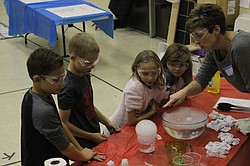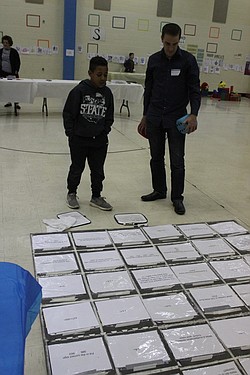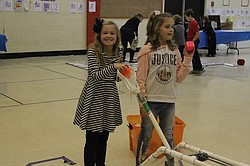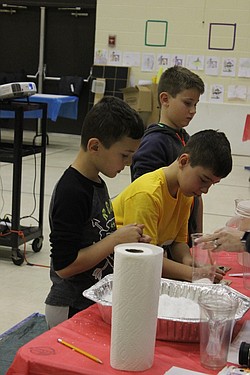Neighbors | Abby Slanker.A group of Hilltop Elementary School third-graders learned about sublimation and chemical reaction using dry ice at a science station during the school’s annual STEM Week on Nov. 8.
Neighbors | Abby Slanker.A Hilltop Elementary School third-grade student contemplated the Minecraft activity at a math station with the help of a volunteer during the school’s annual STEM Week on Nov. 8.
Neighbors | Abby Slanker.Hilltop Elementary School third-grade students prepared to launch blocks at a structure built by their classmates at an engineering station during the school’s annual STEM Week.
Neighbors | Abby Slanker.At a science station, Hilltop Elementary School third-graders measured materials to create instant snow during the school’s annual STEM Week.
By ABBY SLANKER
Students at Hilltop Elementary School participated in STEM Week at the school Nov. 5-9.
STEM Week, which stands for Science, Technology, Engineering and Math, was created by a group of Hilltop parents and has been improved upon and evolved each year.
Each grade had its own designated STEM day with activities which were grade level/age appropriate. The activities were also tied into each grade level’s curriculum.
“Each grade has their own STEM activities, which are geared toward what they are learning in the classroom,” said Kelly Volovar, STEM Week chair and third-grade STEM chair.
Each class had one hour in the gym to explore each of the hands-on activities at seven stations. PTO parent volunteers supervised the activities and served as grade-level chairs. Mandy Harris served as STEM Week co-chair.
Volovar said the parent volunteer response was great.
“We had a great response for volunteers. We have parents, grandparents and even past parents whose children have moved on from Hilltop come back to help us out. I think it’s so nice for them to come back and help us. It’s been amazing,” Volovar said.
Each class was divided into groups, with each group assigned to a station and then the groups rotated through the science, technology, engineering and math stations, spending approximately eight minutes at each station.
For the third-graders, there were two engineering stations. At the first station, students were asked to build a structure with blocks and several items which could withstand balls and other items shot from a catapult at the other engineering station.
At the science stations, students were taught about sublimation and chemical reaction using dry ice and they then experimented with instant snow, helping to measure and weight the materials. Students could also hypothesize about what would happen when water was added to the instant snow material.
For the math stations, students played a giant game of Minecraft, solving problems and using graphing skills and also played a game of War with oversized multiplication flash cards, using their fast math skills. The Minecraft game was also a competition between the third-grade classrooms, with students keeping track of their correct answers on a piece of poster board.
The technology station, which changes each year, was the same for kindergarten through fourth grade. This year, the students experienced airplane simulation using iPads and a poster of an airplane cockpit on the wall.
“This year our technology station is airplane simulation. We had Captain Marty Hutchinson of the 910th Airlift Wing at the Youngstown Air Reserve Station volunteer to come visit with our second-graders and fourth-graders. He interacted with the kids and brought military gear and equipment that can be found on planes like goggles, helmets and maps that they use to navigate around our region,” Volovar said.
Volovar also said the students quickly picked the airplane simulation.
“When it was the kindergartners using it, all we had to do was explain it to them and they ran with it. And with the older kids, the picked it up very quickly and were even changing settings in the program to make the simulation more difficult, like adding snow and rain. It was pretty impressive,” Volovar said.
A Look and See table was set up in the middle of the gym for students to explore several items related to science, technology, engineering and math, including fossils, rocks, magnets and kaleidoscopes.
“It’s been really good working with the teachers and students. The kids enjoy this week and look forward to seeing what the new experiments are for their new grade level. They take the skills they are leaning in the classroom and apply them to the experiments during STEM Week,” Volovar said.
 43
43




